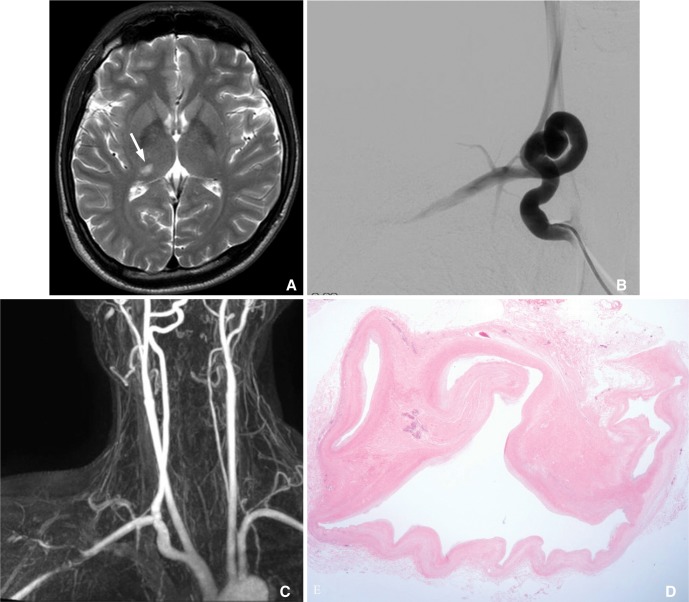Neurointervention.
2014 Feb;9(1):53-55. 10.5469/neuroint.2014.9.1.53.
Cerebral Infarction Caused by a Tortuous Subclavian Artery: a Case Report
- Affiliations
-
- 1Department of Neurology, Bundang Jesaeng General Hospital, Seongnam, Korea. nmgoose@naver.com
- 2Department of Thoracic and Cardiovascular Surgery, Bundang Jesaeng General Hospital, Seongnam, Korea.
- 3Department of Neurosurgery, Bundang Jesaeng General Hospital, Seongnam, Korea.
- 4Department of Pathology, Bundang Jesaeng General Hospital, Seongnam, Korea.
- KMID: 1910776
- DOI: http://doi.org/10.5469/neuroint.2014.9.1.53
Abstract
- Tortuous arteries are common clinical observation. Although mild tortuosity is asymptomatic, severe tortuosity can lead to ischemic attack in several organs. With advances in imaging technology, an increasing number of tortuous vessels have been detected. The purpose of this report is to describe a case of acute cerebral infarction due to tortuous subclavian artery and to review the literature.
Figure
Reference
-
1. North KN, Whiteman DA, Pepin MG, Byers PH. Cerebrovascular complications in Ehlers-Danlos syndrome type IV. Ann Neurol. 1995; 38:960–964. PMID: 8526472.
Article2. Pancera P, Ribul M, Presciuttini B, Lechi A. Prevalence of carotid artery kinking in 590 consecutive subjects evaluated by Echocolordoppler. Is there a correlation with arterial hypertension? J Intern Med. 2000; 248:7–12. PMID: 10947875.
Article3. Benes V, Netuka D. Surgical correction of symptomatic vertebral artery kinking. Br J Neurosurg. 2003; 17:174–178. PMID: 12820762.4. Hiroki M, Miyashita K, Oda M. Tortuosity of the white matter medullary arterioles is related to the severity of hypertension. Cerebrovasc Dis. 2002; 13:242–250. PMID: 12011548.
Article5. Callewaert BL, Willaert A, Kerstjens-Frederikse WS, De Backer J, Devriendt K, Albrecht B, et al. Arterial tortuosity syndrome: clinical and molecular findings in 12 newly identified families. Hum Mutat. 2008; 29:150–158. PMID: 17935213.
Article6. Sugawara J, Hayashi K, Yokoi T, Tanaka H. Age-associated elongation of the ascending aorta in adults. JACC Cardiovasc Imaging. 2008; 1:739–748. PMID: 19356510.
Article
- Full Text Links
- Actions
-
Cited
- CITED
-
- Close
- Share
- Similar articles
-
- Distal Subclavian Artery Occlusion Causing Multiple Cerebral Infarcts Consequence of Retrograde Flow of a Thrombus?
- Risk of continuing planned surgery after endovascular repair of subclavian artery injury: a case report
- A Case Report Hemiparesis Caused by Ipsilateral Middle Cerebral Artery Infarction
- Meningioma Presenting as Cerebral Infarct: Case Report
- Spontaneous Subclavian Artery Dissection Presenting as Posterior Circulation Infarction


